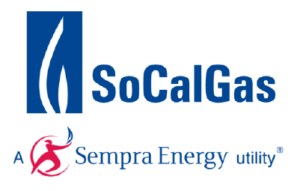Nation’s largest gas utility is helping lead the transition to a decarbonized energy system
LOS ANGELES–July 26, 2021—Southern California Gas Co. (SoCalGas) today announced several of its
research and development initiatives designed to enable low-cost, clean hydrogen have been submitted
to the U.S. Department of Energy’s (DOE) “Earthshot” Hydrogen Program’s Request for Information
(RFI). The submissions are intended to help DOE’s Hydrogen Program prioritize projects that would
accelerate clean hydrogen innovations that could reduce emissions, create jobs, and facilitate a net-zero
carbon emissions economy by 2050. SoCalGas is working with multiple collaborators on these
initiatives, including the University of California Irvine, University of California Los Angeles, and the
Green Hydrogen Coalition, among others.
“Green hydrogen is a renewable energy source that can be ready-to-go whenever it’s needed for power
generation, manufacturing, or transportation,” said Maryam Brown, SoCalGas President. “We believe
this flexible, storable fuel will be essential to achieving net-zero emissions in California, and that is why
we are working collaboratively with these partners to advance these important hydrogen projects.”
SoCalGas recently announced its commitment to the goal of achieving net zero greenhouse gas
emissions in its operations and delivery of energy by 2045. In doing so, SoCalGas became the largest gas
distribution utility in the nation to include scopes 1, 2, and 3 emissions in its target, aligning with the
Paris Agreement’s recommendations to limit global warming to 1.5°C by achieving net zero by mid-century.
The programs submitted to the DOE request include:
• HyDeal LA: An initiative to architect the green hydrogen ecosystem to achieve at-scale procurement
of green hydrogen at $1.50/kg in the Los Angeles basin by 2030. HyDeal LA is a collaboration of
green hydrogen offtakers, developers, integrators, equipment manufacturers, investors,
environmental groups, and other advisors coalescing to overcome the biggest barrier to the green
hydrogen economy–its high cost–by aiming to launch North America’s first green hydrogen hub at
scale. HyDeal LA is targeting the inclusion of power plants, industrial applications, hydrogen
transportation, and ultimately, global export of green hydrogen from the ports.
• Renewable Hydrogen Ecosystem: A project at the University of California, Irvine (UCI) that will be
designed to use hydrogen made from solar and wind energy to create a zero-emissions energy
system on the UCI campus. If successful, this project would demonstrate a scalable solution that
could be replicated by urban communities around the world to achieve zero emissions.
• Direct Solar Methane Conversion: A new technology developed by researchers at the University of
California Los Angeles (UCLA) that uses solar energy to separate the carbon and hydrogen atoms in
natural gas with zero or negative emissions, creating hydrogen and capturing carbon in solid form,
which can be used in high value energy technology applications when commercialized.
“The Western United States has abundant renewable resources necessary to make globally-competitive
low-cost green hydrogen,” said Janice Lin, President and Founder of the Green Hydrogen Coalition. “By
working to simultaneously aggregate multi-sectoral demand, scale production, and design the needed
infrastructure for transport and storage, HyDeal LA aims to make use of these renewable resources to
produce and deliver green hydrogen at scale to accelerate multi-sectoral decarbonization in power
plants, transportation, and as a feedstock for industrial customers. HyDeal LA represents an opportunity
for the U.S. Department of Energy to promote the development of domestic green hydrogen hubs and
establish the U.S. as a leader for this vast new emerging energy export opportunity.”
“By using solar energy converted to hydrogen, we aim to create a 100% zero-carbon energy system on
the UC Irvine campus,” said Jack Brouwer, director of UCI’s National Fuel Cell Research Center as well as
its Advanced Power and Energy Program. “When deployed, the system we’re proposing could be
replicable at other universities, industrial campuses, large apartment complexes, military bases, and
other multi‐megawatt microgrids across the nation.”
“The new clean hydrogen production technology developed by UCLA researchers represents a disruptive
breakthrough,” said Tim Fisher, Professor and Chair of UCLA’s Mechanical and Aerospace Engineering
department. “When commercialized, this technology could drive the U.S. as a leader in zero carbon
technology development, domestic jobs growth, and the production of clean hydrogen at very low-cost.”
In its RFI, the DOE notes that hydrogen “enables innovations in energy production and end uses that can
help decarbonize some of the most emissions-intensive sectors of our economy: transportation,
electricity generation, and industrial applications, including chemicals production. Additional
decarbonization opportunities exist for low-carbon hydrogen such as for combined heat and power
(CHP) in building applications and through blending with natural gas.”
For more information on SoCalGas’ mission and climate commitment to net zero by 2045, visit
www.socalgas.com/mission.
About SoCalGas
Headquartered in Los Angeles, SoCalGas® is the largest gas distribution utility in the United States. SoCalGas
delivers affordable, reliable and increasingly renewable gas service to 21.8 million consumers across 24,000
square miles of Central and Southern California. Gas delivered through the company’s pipelines will continue
to play a key role in California’s clean energy transition—providing electric grid reliability and supporting
wind and solar energy deployment.
SoCalGas’ mission is to build the cleanest, safest, and most innovative energy company in America. In support
of that mission, SoCalGas is committed to its goals of achieving net-zero greenhouse gas emissions in its
operations and delivery of energy by 2045 and replacing 20 percent of its traditional natural gas supply to
core customers with renewable natural gas (RNG) by 2030. Renewable natural gas is made from waste
created by dairy farms, landfills, and wastewater treatment plants. SoCalGas is also committed to investing in
its gas delivery infrastructure while keeping bills affordable for customers. SoCalGas is a subsidiary of Sempra
(NYSE: SRE), an energy services holding company based in San Diego. For more information
visit socalgas.com/newsroom or connect with SoCalGas on Twitter (@SoCalGas), Instagram (@SoCalGas)
and Facebook


